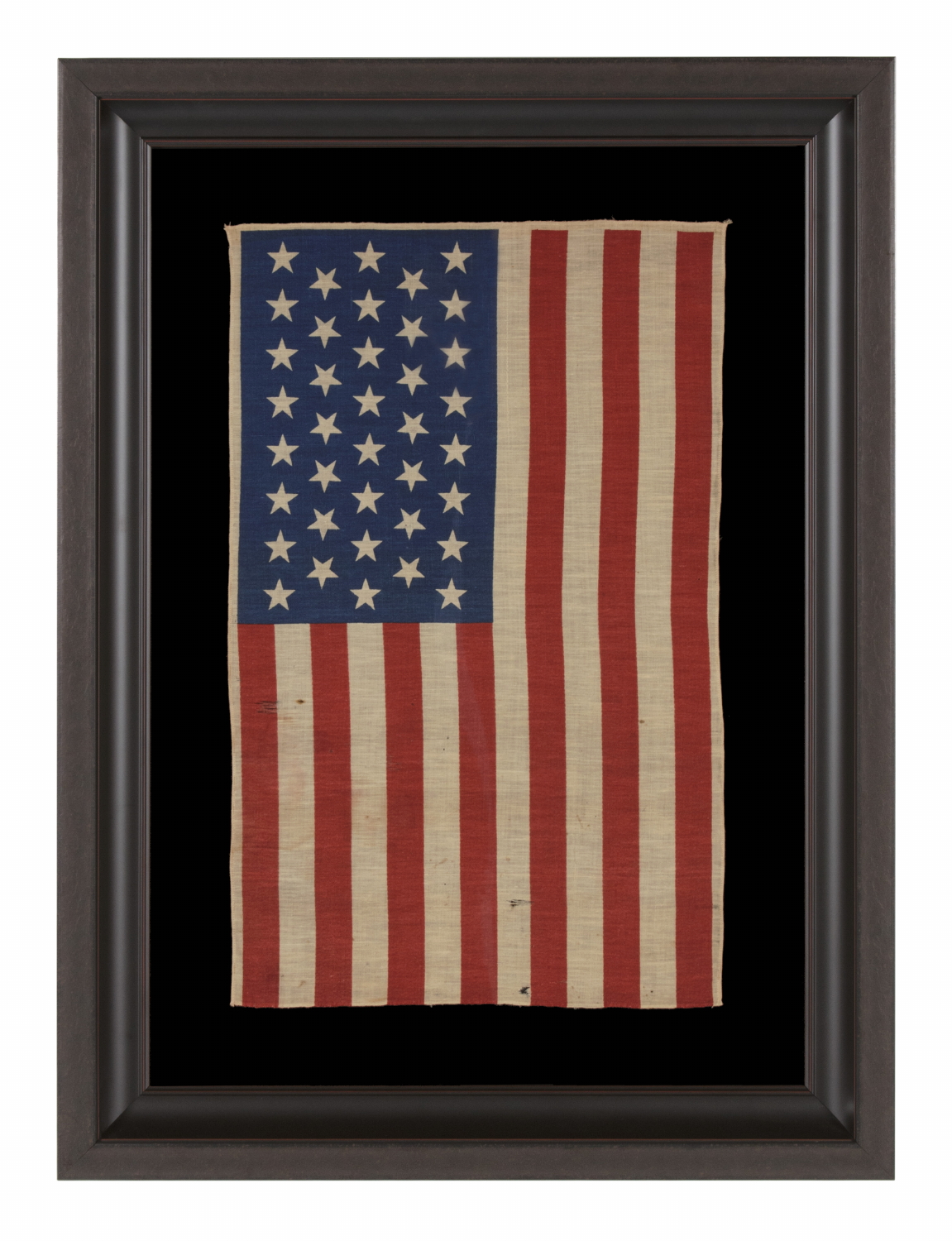
| |
38 STARS IN A LINEAL ARRANGEMENT THAT IS COMPRISED OF JUST 5 ROWS OF CANTED STARS, UNUSUAL FOR A PARADE FLAG IN THIS STAR COUNT, PROBABLY MADE FOR THE CENTENNIAL INTERNATIONAL EXHIBITION IN PHILADELPHIA IN 1876, THIS STAR COUNT REFLECTING COLORADO STATEHOOD |
|
| Available: |
Sold |
| Frame Size (H x L): |
32.75" x 24" |
| Flag Size (H x L): |
23.25" x 14" |
|
| Description....: |
|
38 star American national parade flag, probably made for use at the centennial of American independence in 1876. The flag is printed on a thin wool and cotton blended fabric, which makes it unusual among its counterparts of the period. The reason for the inclusion of wool was that it sheds water, making it an obvious choice for flags that were to be used outdoors over an extended time. Most parade flags were printed on cotton, because it was less expensive and most parades, political rallies and reunions were brief, often lasting just one day. Flags made for these events were thus intended to be used in the immediate short term. The Centennial International Exposition, held in Philadelphia, was the first World’s Fair ever held in America. This six-month-long event served as the focal point of the celebration of our nation’s 100-year anniversary. More than 200 temporary buildings were erected on the 285 acre site, drawing 9 million visitors. Because of its long duration and patriotic purpose, thousands of durable flags were needed for decoration. The construction of this particular flag is akin to others known to have specifically been used at the Expo.
The colors of flags with printed wool construction tend to be saturated and attractive. That is no exception here, noting the strong, royal blue and scarlet red.
The stars of the flag might seem ordinary to the casual observer, but are actually quite unusual in their layout. In 38 star flags with pieced-and-sewn construction, it isn't unusual to encounter stars arranged in 5 lineal rows, but on parade flags it is unknown, I believe, outside this specific variety. This is why, to someone more familiar with the various types, the rows may seem unusually long.
Note also how the vertical orientation of the stars alternates from one row to the next. In the first they are canted so that one point is directed toward the 1:00 position, and in the second row they are canted so that one point is directed toward 11:00, and so-on. This lends a degree of movement and thus adds a nice visual feature to the design.
Parade flags are printed on one side only, and the color bleeds through to the other side. This results in a two-sided flag, but one side is always stronger than the other. In the case of all known flags in this unusual style, all are stronger on the reverse, meaning that that side is best displayed. When the flag is oriented in its correct vertical position, with the canton in the upper left (as specified by the modern flag code, which didn't exist during the 19th century), note that the stars in the first column are oriented with one point up, and in the next they are oriented with one point down. This is an interesting curiosity and an attractive trait.
Colorado became the 38th state on August 1st, 1876. Per the Third Flag Act of 1818, stars were not officially added until the 4th of July following a state's addition. For this reason, 37 was the official star count for the American flag in 1876. Flag-making was a competitive venture, however, and few flag-makers would have been continuing to produce 37 star flags when their competitors were making 38’s. It is for this reason that 38 and 13 stars (to represent the original 13 colonies) are more often seen at the Centennial International Exposition. Some flag-makers would have been adding a star for the 38th state even before it entered the Union, in the early part of 1876 or even prior. In fact, many makers of parade flags were actually producing 39 star flags, in hopeful anticipation of the addition of two more Western Territories instead of one. But the 39th state would not join the Union for another 13 years, when the Dakota Territory entered as two states on the same day. The 38 star flag became official on July 4th, 1877 and was generally used until the addition of the Dakotas in 1889.
Mounting: The flag has been hand-stitched to a background of 100% cotton twill, black in color, which was washed to reduce excess dye. An acid-free agent was added to the wash to further set the dye and the fabric was heat-treated for the same purpose. The mount was then placed in a two-part combination of moldings. The outer molding is square with a gunmetal finish. The inner has a deep cove profile and is very dark brown, almost black, with subtle red highlights. The glazing is U.V. protective plexiglass.
Condition: There is minor fabric breakdown in the stripe field between the center of the flag and the fly end and there are some tiny holes elsewhere in this area, along with minor foxing and staining. Many of my clients prefer early flags to show their age and history of use. |
|
|
|
| Collector Level: |
Intermediate-Level Collectors and Special Gifts |
|
| Flag Type: |
Parade flag |
|
| Star Count: |
38 |
|
| Earliest Date of Origin: |
1876 |
|
| Latest Date of Origin: |
1889 |
|
| State/Affiliation: |
Colorado |
|
| War Association: |
1866-1890 Indian Wars |
|
| Price: |
SOLD |
|
| |
Views: 3133 |
|
|
|

